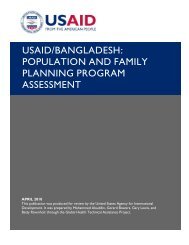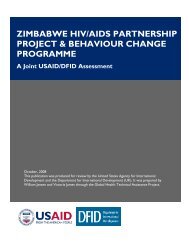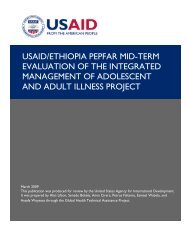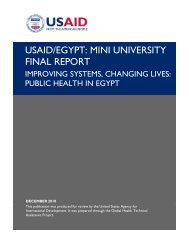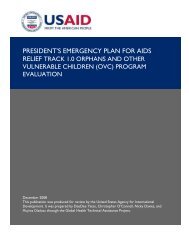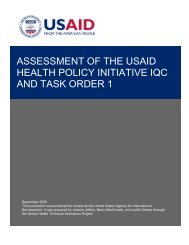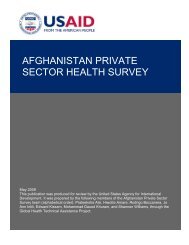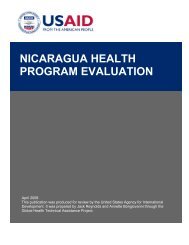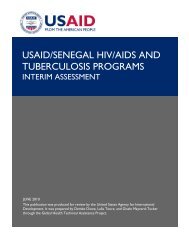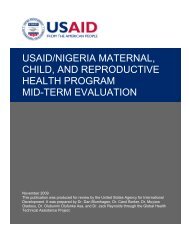Evaluation of the Tuberculosis Control Assistance Program (TB CAP)
Evaluation of the Tuberculosis Control Assistance Program (TB CAP)
Evaluation of the Tuberculosis Control Assistance Program (TB CAP)
Create successful ePaper yourself
Turn your PDF publications into a flip-book with our unique Google optimized e-Paper software.
In general, however, it is expected that planning will be done in cooperation with <strong>the</strong> NTP and itsapproval gained before workplan and budget are submitted for approval to first <strong>the</strong> PMU, <strong>the</strong>n <strong>the</strong>Mission, and <strong>the</strong>n <strong>the</strong> USAID CTO.In most countries <strong>the</strong> <strong>TB</strong> <strong>CAP</strong> coordinating partner works closely with <strong>the</strong> NTP, and <strong>the</strong> workplanreflects NTP priorities. Some Missions reported <strong>the</strong>y were heavily involved in drafting <strong>the</strong> workplan,o<strong>the</strong>rs that <strong>the</strong>y received only a final draft. A few NTPs reported that <strong>the</strong>y saw a proposed workplan onlyafter it was nearly complete. In some countries <strong>the</strong> Mission or NTP asked <strong>TB</strong> <strong>CAP</strong> for short-term, limitedTA so <strong>the</strong> planning was limited to <strong>the</strong> specific activity requested.Regardless <strong>of</strong> <strong>the</strong> variances, however, <strong>the</strong>se aberrations were almost always based on <strong>the</strong> desires <strong>of</strong> <strong>the</strong>participants. None <strong>of</strong> those interviewed complained that <strong>the</strong>y were excluded from a part <strong>of</strong> <strong>the</strong> process inwhich <strong>the</strong>y wanted to participate or that <strong>the</strong> change in process directly resulted in poor implementation.Some did refer to inconveniences or inefficiencies resulting from <strong>the</strong>ir not being involved earlier andexpressed a desire to be included in <strong>the</strong> future. However, it seems likely that <strong>the</strong> greatest negative impact<strong>of</strong> <strong>the</strong>se variances is <strong>the</strong> lack <strong>of</strong> clarity on how <strong>the</strong> process should be performed, and a lack <strong>of</strong> evidencefor consensus on <strong>the</strong> single most effective approach (regardless <strong>of</strong> individual wishes) to develop aworkplan.Sometimes changes in Mission or NTP priorities require that <strong>TB</strong> <strong>CAP</strong> fill in gaps by adjusting <strong>the</strong>activities in <strong>the</strong> workplan. <strong>TB</strong> <strong>CAP</strong> is seen by NTPs as a source <strong>of</strong> flexible financing that can plug gaps tokeep <strong>the</strong> program going.RecommendationsIn countries where <strong>TB</strong> <strong>CAP</strong> assistance is requested for multiple years, initial workplans should beapproved for <strong>the</strong> entire term, with annual adjustments to correspond as closely as possible tosequential needs identified in national strategic <strong>TB</strong> plans and based an <strong>the</strong> availability <strong>of</strong> funds.For multiyear workplans, a realistic and longer timeframe should be allowed for planning andapproval <strong>of</strong> <strong>the</strong> initial plan. Shorter, more streamlined planning and approval processes should applyto annual updates.The PMU should determine an acceptable lead time for workplan development, identify projects thatfar exceed that time, and analyze <strong>the</strong> causes <strong>of</strong> delays. The PMU should <strong>the</strong>n identify strategies toreduce delays, such as <strong>the</strong> use <strong>of</strong> tools like workplan templates to facilitate faster start-up or closeroversight and management <strong>of</strong> <strong>the</strong> work planning process by PMU staff.Missions should allocate annual <strong>TB</strong> <strong>CAP</strong> funds based as closely as possible on annual workplanadjustments and budget requirements.There is a need for defining and providing guidance on logical, sequential, incremental steps NTPsshould take, depending on how developed <strong>the</strong>ir program is.Approving Country WorkplansSome consider approval by <strong>the</strong> USAID Mission and USAID/Washington for procurement to be a problemthat causes delays. This problem is seen as having improving over time, with <strong>the</strong> USAID CTO movingdecisions along.A common concern <strong>of</strong> partners is that approval <strong>of</strong> workplans is delaying implementation. Often <strong>the</strong> timeto develop or approve a workplan seems excessive. Based on a random sample <strong>of</strong> 10 workplans, four tookmore than four months to develop a draft, and in four instances Mission approval took two or moremonths. USAID CTO approval seems faster, with only two plans requiring more than 40 days (averageEVALUATION OF THE TUBERCULOSIS CONTROL ASSISTANCE PROGRAM (<strong>TB</strong> <strong>CAP</strong>) 17



